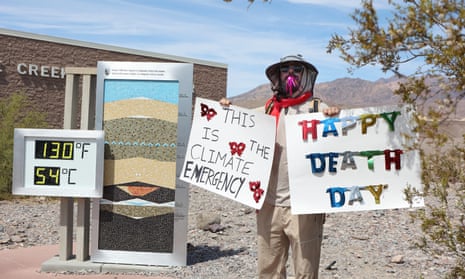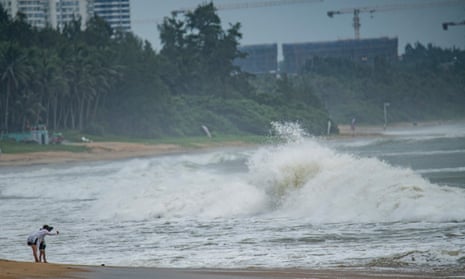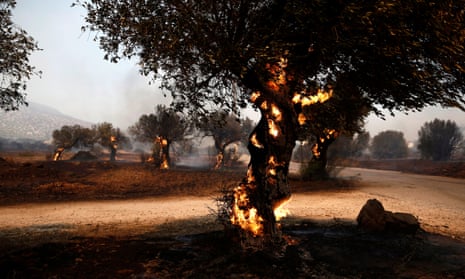Houston, Texas confirms first heat-related death
Houston, Texas has just confirmed its first heat-related death.
Victor Ramos, 67, was found in his home in south-west Houston, which did not have air conditioning. He died on 24 June in hospital. Ramos’ sister Karla told local Houston news outlet KHOU that her brother Ramos could not afford to fix his broken AC unit since he was let go from his job in March.
In nearby Pearland, Texas, Felipe Pascaul, 46, also died from the heat on 16 June. Pascaul was pouring concrete on a construction job site when he went into cardiac arrest and collapsed. He was taken to a hospital but did not survive.
The news comes after Texas governor Greg Abbott approved a law in June that eliminated water breaks for construction workers mandated by cities and counties in the state.
The state has seen 14 heat-related deaths this year as of June. Last year, 306 people died in connection to the dangerously high temperatures in Texas.
Texas’s most populous city and the fourth most populous city in the US, Houston is one of many around the country, particularly in the southwest, placed on a heat advisory.
Heat Advisories are again in effect today and tomorrow as heat indices rise to near 110°F this afternoon.
🥤Stay hydrated
🚫🏃Limit strenuous outdoor activities
😎Take frequent breaks in A/C or the shade if outside
🚙Never leave children or pets in off vehicles#HOUwx #TXwx pic.twitter.com/70QCU7bG6B— NWS Houston (@NWSHouston) July 17, 2023
Key events
Evacuation efforts are under way in Greece, where uncontrolled fires are ravaging coastal towns near the capital of Athens, Reuters reports.
In the village of Kouvaras, a witness told Reuters at least five houses were severely damaged. In Kalyvia and Anavyssos, police helped evacuate at least 100 people and dozens of horses.
There are 81 blazes in total across the country, authorities said. The news agency further reports:
More than 200 firemen assisted by 20 soldiers, 68 fire engines, 10 aircraft and six helicopters were fighting the flames.
Coast guard boats were patrolling along the coast to help evacuate citizens if needed, and more vessels were on standby in case they needed to intervene.
Around 1,200 children in a summer camp and the residents of a rehabilitation centre were evacuated due to another wildfire burning close to the seaside resort of Loutraki, about 50 miles west of Athens, a local mayor told Greek television.
About 135 firemen with 50 fire engines, 40 soldiers and 13 aircraft had been deployed to contain that blaze which forced police to shut part of a highway and disrupted train services.
Greece’s prime minister, Kyriakos Mitsotakis, who is currently at a leaders’ summit in Brussels, said that he was being constantly briefed over the fires.
He said: “Today was the first really tough day of this summer. It is certain that more will follow. We’ve had, we have and will have fires, which is also one of the results of the climate crisis that we experience with increased intensity.”
Fires are likely to persist this week, the Greek meteorological service has warned.
Arizona senator and former astronaut Mark Kelly issued a warning on the climate crisis in an attempt to bring skeptics and the unconcerned back down to earth.
Particularly in his state, temperatures have reached 110F (43.3C) or over every day in the last two weeks.
Kelly, who has been to space four times, told Jake Tapper on CNN’s State of the Union on Sunday that while in space, he could see how thin the atmosphere was over the planet.
“It’s as thin as a contact lens on an eyeball. We have to do a better job taking care of it,” he said.
If the heatwave continues at this rate, Arizona will shatter its record for the amount of days where temperatures consistently reached above 110F (43.3C) by Tuesday. Currently, the record is 18 days. Temperatures are highest in the capital of Phoenix, America’s hottest city.
Northern Hemisphere boils
Temperatures continued to reach extreme highs across many parts of the northern hemisphere on Monday.
The mercury in parts of Italy is poised to hit 45C on Tuesday and wildfires raging in Greece and Spain are signalling the latest fierce warning of the effects of the climate crisis, report the Guardian’s Angela Giuffrida in Rome and Helena Smith in Athens.
In Italy, where temperatures later in the week could push close to the European record of 48.8C, set in the Sicilian town of Floridia in August 2021, Italians were warned to brace themselves for “the most intense heatwave of the summer and also one of the most intense of all time”.
As heatwaves engulfed the globe, temperatures in California’s Death Valley, often among the hottest places on Earth, approached a world record on Sunday after reaching 53.3C.
China on Sunday issued several temperature alerts, warning of 39C in southern Guangxi region and 40-45C in the partly desert region of Xinjiang, where a temperature of 52.2C was recorded in the remote Sanbao township. In Japan, 60 people were treated for heatstroke as temperatures in the country reached highs of 39.1C.
In a stark warning to world leaders earlier on Monday, Tedros Adhanom Ghebreyesus, the director general of the World Health Organization, wrote on Twitter: “In many parts of the world, today is predicted to be the hottest day on record. And these records have already been broken a few times this year. Heatwaves put our health and lives at risk. The #ClimateCrisis is not a warning. It’s happening. I urge world leaders to act now.”
You can read more of this report here.
As the US continues to struggle with extreme heat and temperature records look set to tumble in several areas, we’d like to hear from people whose air conditioning systems or units are giving up due to having to run for longer and in more intense conditions.
If you are in this position, we’re interested how long it’s taken or taking to get your AC fixed or replaced, and how issues with your AC have affected your ability to cope with heatwaves.
We’re also keen to hear from people who can’t afford AC or can’t afford to use it very much. How are you cooling your home? What measures are you able to take to stay safe in the heat? Or are you struggling to find relief from the hot weather due to a lack of cooling options.
Get in touch:
Visitors have been flocking to Death Valley despite temperatures in the park getting close to breaching the highest levels ever recorded before.
More than 1.1 million people annually visit the desert park, which sits over a portion of the California-Nevada border west of Las Vegas. At 5,346 sq miles (13,848 sq km), it is the largest national park in the Lower 48. About one-fifth of the visitors come in June, July and August.
People have been posing for pictures in the scorching weather despite warnings over heat exposure:



Not everyone has been taking a light-hearted approach to the temperatures in the park though. A protester at the weekend was warning visitors about the climate crisis:

The Greek wildfires near Athens and the region are prompting some dramatic footage and images on social media. Here are some interesting tweets.
After a lull, the wildfire season in Greece has begun.
A large fire has broke out in the Attica Region of the county, which incorporates Athens.
Evacuations have been ordered, including a children’s camp of 1,200 kids. The cause is under investigation. pic.twitter.com/A6bioVPgsq
— The Hotshot Wake Up (@HotshotWake) July 17, 2023
Bad air quality ahead of sundown.
Skyline.
You can almost feel the heat.
Meanwhile, back in Greece, we have a video report on the wildfires causing destruction near Athens.
People were ordered to leave their homes south-east of the capital on Monday as the flames, fanned by strong winds, burned nearby vegetation.
The blaze was raging close to buildings in the village of Kouvaras, about 27km (17 miles) from the Greek capital, and threatening other settlements, the civil protection service said.
In Kalyvia, horses were evacuated from stables that had caught light.
California congressman Adam Schiff has called for a push to pass clean energy laws to help mitigate the effects of the climate crisis.
Schiff wrote on Twitter: “As blistering temperatures continue to surge in California, the south-west and beyond, millions of families and workers will suffer from intense heat and dehydration. Some will lose their lives.”
As blistering temperatures continue to surge in California, the Southwest and beyond, millions of families and workers will suffer from intense heat and dehydration. Some will lose their lives.
The devastating impacts of climate change are here, and we must act now and pass…
— Adam Schiff (@RepAdamSchiff) July 17, 2023

Joanna Walters
Local authorities in Guangdong province, southern China, have ordered the closure of 68 coastal tourist destinations and called back 2,702 fishing vessels as Typhoon Talim hits, Reuters reports that the Xinhua news agency is stating.
The authorities have also ordered many thousands of workers on offshore fish farms in the area to be evacuated. Earlier, it was confirmed that almost a quarter of a million people had been evacuated to safety ahead of the typhoon’s landfall in China.
For our global readers, it’s worth reminding everyone that the US National Oceanic and Atmospheric Administration (Noaa), a federal government agency, notes that “the only difference between a hurricane and a typhoon is the location where the storm occurs.”
Hurricane season is under way in the North Atlantic the climate crisis and El Niño pattern are bringing named storms earlier and likely to make them more fierce, especially as ocean temperatures warm relatively dramatically.
Noaa notes that hurricanes and typhoons are the same weather phenomenon: tropical cyclones.
The agency adds:
Once a tropical cyclone reaches maximum sustained winds of 74 miles per hour or higher, it is then classified as a hurricane, typhoon, or tropical cyclone, depending upon where the storm originates in the world.
In the North Atlantic, central North Pacific, and eastern North Pacific, the term hurricane is used. The same type of disturbance in the Northwest Pacific is called a typhoon. Meanwhile, in the South Pacific and Indian Ocean, the generic term tropical cyclone is used, regardless of the strength of the wind associated with the weather system.
Typhoon Talim makes landfall in China
Typhoon Talim became the first typhoon to make landfall in China this year, hitting the country on Monday evening local time and prompting authorities to issue flood warnings, cancel flights and trains, and order people to stay at home, Reuters reports. The storm sideswiped Hong Kong earlier.
The news agency further reports:
Talim, the fourth typhoon of the year, made landfall at 10.20pm local time (1420 GMT) in Zhanjiang city, Guangdong province, with winds near its centre clocked at a top speed of 136.8 kph (85 mph), according to Guangdong weather bureau. Winds stronger than 150 kph would put Talim in the severe typhoon category, very rare for a typhoon this early in the rainy season.
Talim is expected to move at a speed of 20 km per hour northwest and into Guangxi region early on July 18, Guangdong weather bureau added. China’s meteorological centre forecast gale force winds in seas near southern provinces and regions and exceptionally heavy rains of 250-280 mm (9.8-11 inches) on the southwestern coast of Guangxi and northern Hainan Island. Parts of Guangxi were told to brace for flash floods through Tuesday.

Houston, Texas confirms first heat-related death
Houston, Texas has just confirmed its first heat-related death.
Victor Ramos, 67, was found in his home in south-west Houston, which did not have air conditioning. He died on 24 June in hospital. Ramos’ sister Karla told local Houston news outlet KHOU that her brother Ramos could not afford to fix his broken AC unit since he was let go from his job in March.
In nearby Pearland, Texas, Felipe Pascaul, 46, also died from the heat on 16 June. Pascaul was pouring concrete on a construction job site when he went into cardiac arrest and collapsed. He was taken to a hospital but did not survive.
The news comes after Texas governor Greg Abbott approved a law in June that eliminated water breaks for construction workers mandated by cities and counties in the state.
The state has seen 14 heat-related deaths this year as of June. Last year, 306 people died in connection to the dangerously high temperatures in Texas.
Texas’s most populous city and the fourth most populous city in the US, Houston is one of many around the country, particularly in the southwest, placed on a heat advisory.
Heat Advisories are again in effect today and tomorrow as heat indices rise to near 110°F this afternoon.
🥤Stay hydrated
🚫🏃Limit strenuous outdoor activities
😎Take frequent breaks in A/C or the shade if outside
🚙Never leave children or pets in off vehicles#HOUwx #TXwx pic.twitter.com/70QCU7bG6B— NWS Houston (@NWSHouston) July 17, 2023

Joanna Walters
The relentless heatwave across the southern US continues to scorch Texas, with dangerous conditions.
Amid the risk to people’s health, especially those obliged to be outside in the heat, soaring demand for energy is putting strain on the system – although, as the Guardian reported late last month, renewable power sources are helping the state maintain energy reliability, contrary to some of the state’s lawmakers claims that clean energy is less reliable.
This week could break records for demand, though, with homes and business keeping their air conditioners cranked, as Reuters reports:
The Electric Reliability Council of Texas (Ercot), which operates the grid for more than 26 million customers representing about 90% of the state’s power load, has said it has enough resources available to meet soaring demand.
Texas residents have worried about extreme weather since a deadly storm in February 2021 left millions without power, water and heat for days as Ercot struggled to prevent a grid collapse after the closure of an unusually large amount of generation.
Although overall US power demand is projected to ease in 2023 after hitting a record high in 2022, rising economic and population growth is expected to keep boosting electric use in “Sun Belt” states like Texas.
After setting 11 demand records last summer, Ercot forecast usage would hit 83,732 megawatts (MW) on Monday and 85,237 MW on Tuesday this week. That would be the fourth record high this summer. One megawatt can power around 1,000 US homes on a typical day, but only about 200 homes on a hot summer day in Texas.

Summary
-
The UK government’s new plan to cope with the climate crisis has been condemned as “very weak” by experts, who say not enough is being done to protect lives and livelihoods.
-
South East Water has reported a pre-tax loss of nearly £75m, which it blamed in part on the cost of dealing with last year’s “extreme weather events” including the record-breaking heatwave. The water firm, which supplies 2.2 million customers, said the weather events cost it £17m.
-
Five people have been killed and two children remain missing after flood waters tore through parts of south-eastern Pennsylvania over the week during the latest round of violent storms to hit the region.
-
China has confirmed a record temperature of 52.2C (126F) in the north-west of the country on Sunday.
-
Italian health officials intensified heat warnings as the mercury in Rome was forecast to near 40C (104F).
-
California’s Death Valley, often among the hottest places on Earth, reached a near-record 52C on Sunday.
-
Firefighters are battling wildfires in the Canary Islands and Greece.
-
The US climate envoy, John Kerry, is in Beijing in an effort to show that the world’s two biggest emitters of greenhouse gases have renewed their focus on tackling the climate crisis.
-
South Korea’s president has vowed to “completely overhaul” the country’s approach to extreme weather from climate change, as the death toll from flooding and landslides rose to 40.
-
Schools and the stock market were closed in Hong Kong on Monday as Typhoon Talim sideswiped the city and headed toward landfall on the Chinese mainland and the island province of Hainan.
-
Villagers in the south-east of Athens were ordered to leave their homes on Monday as a wildfire burned nearby, Greek authorities said. On Monday, the blaze burnt quickly through brush and spread south toward the Attica region and the resorts of Lagonissi, Anavyssos and Saronida.
-
Scientists have warned that a marine heatwave off the coasts of the UK and Ireland poses a serious threat to species. The Met Office has said that global sea surface temperatures in April and May reached an all-time high, and June is likely to follow suit.
Death Valley approaches global heat record as US reels from extreme weather
Long the hottest place on Earth, Death Valley put a sizzling exclamation point on Sunday on a record warm summer that is baking nearly the entire globe by flirting with some of the hottest temperatures ever recorded, meteorologists said.
Temperatures in Death Valley, which runs along part of central California’s border with Nevada, reached 128F (53.3C) on Sunday at the aptly named Furnace Creek, the National Weather Service said.
The hottest temperature ever recorded on Earth was 134F (56.7C) in July 1913 at Furnace Creek, said Randy Ceverny of the World Meteorological Organization, the body recognized as keeper of world records. Temperatures at or above 130F (54.4C) have only been recorded on Earth a handful of times, mostly in Death Valley.
Read more here:
Wild fires rage south of Athens amid urgent pleas to evacuate

Helena Smith
Wild fires raging close to seaside resort settlements south of Athens have destroyed untold numbers of homes and cars. Over the past hour dramatic scenes have unfolded in the coastal resorts of Lagonissi, Saronida and Anavyssos as blazes fanned by high-speed winds have moved in.
Despite Greek authorities issuing precautionary evacuation orders, latest reports indicate that people have been trapped in homes in Lagonissi. Mega TV showed footage of horses and dogs trapped in a riding club in Anavyssos.
Saronida’s longtime former Mayor Petros Philippou told local media: “ The fire is continuously moving threateningly and right now it is above Saronida. People have to leave these areas immediately with care and with calm.”
Firefighters are now fighting on multiple fronts after a blaze broke out in the Kouvara area of eastern Attica earlier today. Panic-stricken Athenians, many of whom have second homes in the area, have rushed to check properties adding to traffic chaos as others flee.

Blazes have also erupted in Corinth and Boeotia with firefighting planes, helicopters and trucks deployed to the areas. Syriza, the left-wing main opposition party, said its thoughts were with all those now at risk of seeing “everything they had spent a lifetime” working [to achieve] lost to the flames. The civil protection ministry is to hold an emergency meeting with firefighters and other forces.

